If you weren't coming to SPX before, you are now: this year's edition will sotlight Fantagraphics' 40 year anniversary with a TRUE all-star line-up including: Joe Sacco, Trina Robbins, Daniel Clowes and The Hernandez Brothers, Carol Tyler, Jim Woodring, Drew Friedman and Ed Piskor.
Add a CommentViewing: Blog Posts Tagged with: Daniel Clowes, Most Recent at Top [Help]
Results 1 - 19 of 19
Blog: PW -The Beat (Login to Add to MyJacketFlap)
JacketFlap tags: Fantagraphics, Trina Robbins, carol tyler, Art Comix, Jim Woodring, SPX, Daniel Clowes, Joe Sacco, Top News, Ed PIskor, the Hernandez Brothers, drew friedman, gary groth, spx 2016, Add a tag
Blog: PW -The Beat (Login to Add to MyJacketFlap)
JacketFlap tags: Art, Daniel Clowes, Add a tag
It’s Oscar week and who better to cover it for the New Yorker than former Oscar nominee Daniel Clowes himself. Clowes ultra-eagerly awaited graphic novel Patience hits in a few weeks. I’ve read it and it’s a mind blower. To say any more would be a spoiler. You know you’re going to read it anyway.
Blog: PW -The Beat (Login to Add to MyJacketFlap)
JacketFlap tags: Fantagraphics, tours, Daniel Clowes, Events, patience, Cartoonists, Add a tag
 Daniel Clowes new graphic novel Patience drops in late winter and it’s sure to be the comic book event of the first half of 2016. Promised as a SF tale about time travel and love, it’s a powerful return for Clowes. And you’ll be able to get your copy signed, and doubtless hear a talk […]
Daniel Clowes new graphic novel Patience drops in late winter and it’s sure to be the comic book event of the first half of 2016. Promised as a SF tale about time travel and love, it’s a powerful return for Clowes. And you’ll be able to get your copy signed, and doubtless hear a talk […]
Blog: PW -The Beat (Login to Add to MyJacketFlap)
JacketFlap tags: Daniel Clowes, Top News, CAFs, comic arts brooklyn 2015, Indies, Add a tag
This year’s Comic Arts Brooklyn Festival will be held November 7-8, in the same configuration as last year — exhibits on the Saturday and panels on the Sunday. AND NO EXHIBITS ON SUNDAY — there was some confusion about that last year but I’m sure everyone will get the drill this time. The poster, by […]
Blog: PW -The Beat (Login to Add to MyJacketFlap)
JacketFlap tags: Cartoonists, Process, Daniel Clowes, Top News, Add a tag
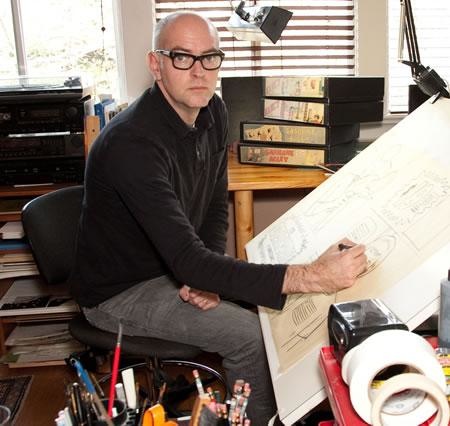
Photo by Abigail Huller, via Oakland Museum of California
Q.
Do you still work the same way you did 25 years ago, drawing by hand at a table?A.
Yes. I was just at an antiquarian book fair, and I picked up this catalog for a cartooning correspondence course from 1921. There was a photo of all the tools you need to use for cartooning in 1921, and it could be a photo of my drawing board: T-square, a watercolor brush, some ink, a pen, an eraser and a pencil. I do the coloring on a computer, but for the drawing I need to not have any screens around me at all.
Ben Sisario chats to the artist about Eightball
And also, more tantalizingly, Patience, which turns out to be a full on SF story that “Energized” the artist.
Q.
Your new book, “Patience,” is a time-travel story, a very common comic-book trope. How did you come to that theme?
A.
At a certain point I realized that the time-travel story, as many times as it’s been done, is an archetype that can go off in any direction. I didn’t want it to be about science of time travel. It’s more about the psychological aspect of what that would mean. I feel like a lot of my work is about time travel in other ways, about memory and living multiple lives at the same time.
Q.
“Patience” is sort of about chasing after a relationship to make it perfect. That’s a poignant topic regardless of the sci-fi aspect.
A.
It had a lot to it, which is why is why I made it as long as it is. One of the main rules I have for working is that as soon as it becomes boring I either get rid of what I have and start over, or go in a completely new direction. And I have to say this one was never boring. It was really energizing to work on from start to finish, even though it was five years.
Blog: PW -The Beat (Login to Add to MyJacketFlap)
JacketFlap tags: Graphic Novels, patience, Fantagraphics, Daniel Clowes, Top News, Add a tag
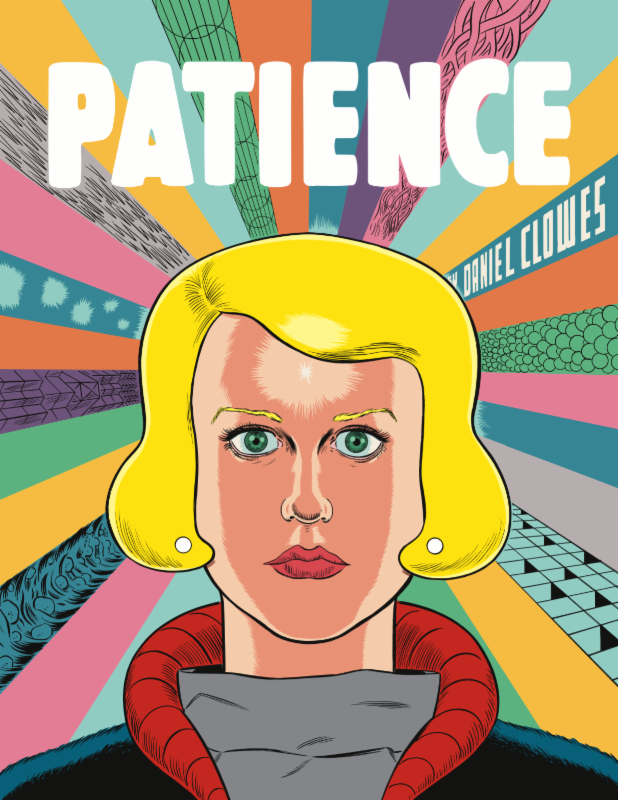
Fantagraphics has been teasing something new from Daniel Clowes for a few weeks and now and here’s the official word: Patience, a new 180-page graphic novel from Clowes is coming in March 2016. It’s described as “an indescribable psychedelic science-fiction love story.” Certainly the art seems like a technicolor throwback to some of Clowes earlier genre-influenced work, as well as The Death Ray.
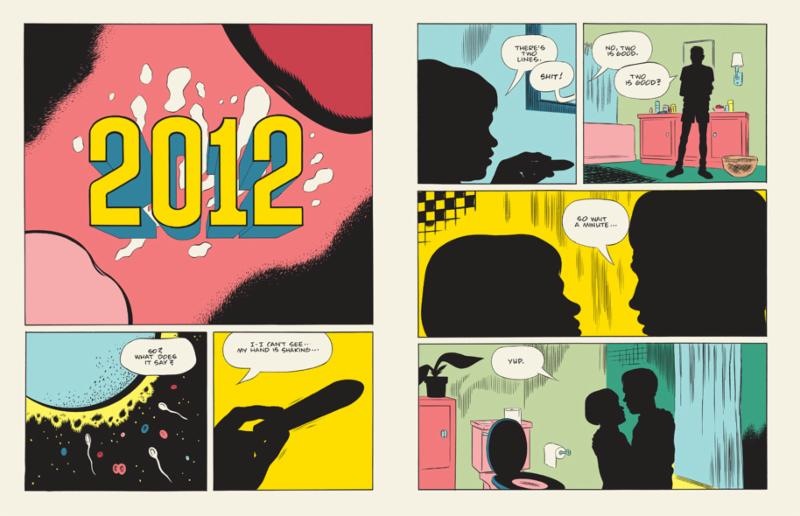
The book veers” with uncanny precision from violent destruction to deeply personal tenderness in a way that is both quintessentially “Clowesian,” and utterly unique in the author’s body of work,” the blurb continues. “This 180-page, full-color story affords Clowes the opportunity to draw some of the most exuberant and breathtaking pages of his life, and to tell his most suspenseful, surprising and affecting story yet.”

“Patience is the best book yet by probably my favorite cartoonist ever,” said Fantagraphics associate publisher Eric Reynolds, “and I can’t wait for people to have the chance to not take my word for it.”
The preliminary cover image, above, also recalls come earlier Clowes work, including the cover to David Boring and the splash pages to some of his Eightball work. But you’ll be able to check all that out for yourself when The Complete Eightball comes out in a few weeks. It’s good to have Daniel Clowes back.
PATIENCE
By Daniel Clowes
180 Pages * Full Color * 7 7/8″ x 10 1/4″
ISBN: 978-1-60699-905-9
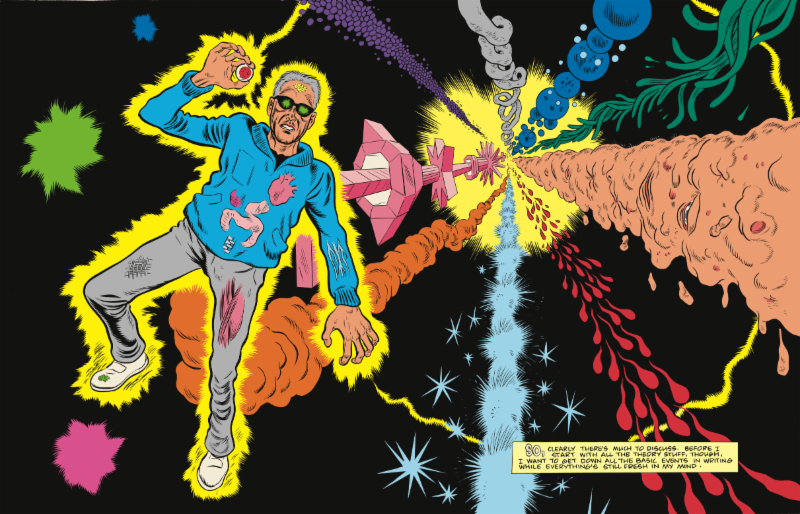
Blog: PW -The Beat (Login to Add to MyJacketFlap)
JacketFlap tags: Top News, Graphic Novels, Fantagraphics, Daniel Clowes, Add a tag
Coming in March 2016. Five years in the making. pic.twitter.com/oChHUyKbQm
— Fantagraphics Books (@fantagraphics) April 6, 2015
It’s been way too long since we’ve heard from Dan Clowes, Shia LaBeouf aside, but the pile of what appears to be artwork in the above tweet suggests he hasn’t been idle.
Clowes’ last work was Wilson, which came out in 2010. (collected versions of Mr. Wonderful, his NY Times comic, and The Death-Ray came out in 2011. In the intervening years he’s been busy with some Hollywood stuff, a major art retrospective and, of course, the Complete Eightball, which is finally coming out in June, squeeee. In 2011, he alluded to a new longer book:
I’m kind of working on a bigger, longer book that I don’t want to talk about or it’ll jinx me. The minute I say, “Oh, I’m doing this,” then the next day I’ll realize I don’t want to do it and I’ll look like an idiot. I’ve done that so many times where somebody will call me up and I’ll mention it one time because I’m excited about it and of course it falls apart and I’m stuck explaining myself for the rest of my life.
In other interviews, Clowes alludes to beginning and abandoning a graphic novel about Hollywood, so this maybe isn’t that but…hey whatever it is, it’s exciting! And only a year to go!
On another note, this marks Clowes’ return to Fantagraphics after some adventures afield with D&Q and Random House. There’s probably a lot more analysis to be made about all that, but we’ll save it for when more than a teaser image is revealed.
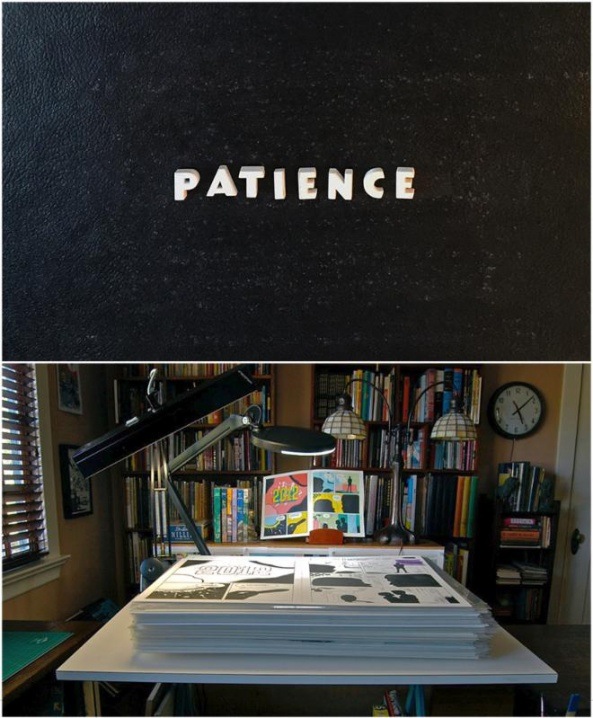
Blog: PW -The Beat (Login to Add to MyJacketFlap)
JacketFlap tags: Art, Fantagraphics, Daniel Clowes, Top News, Eightball, Add a tag
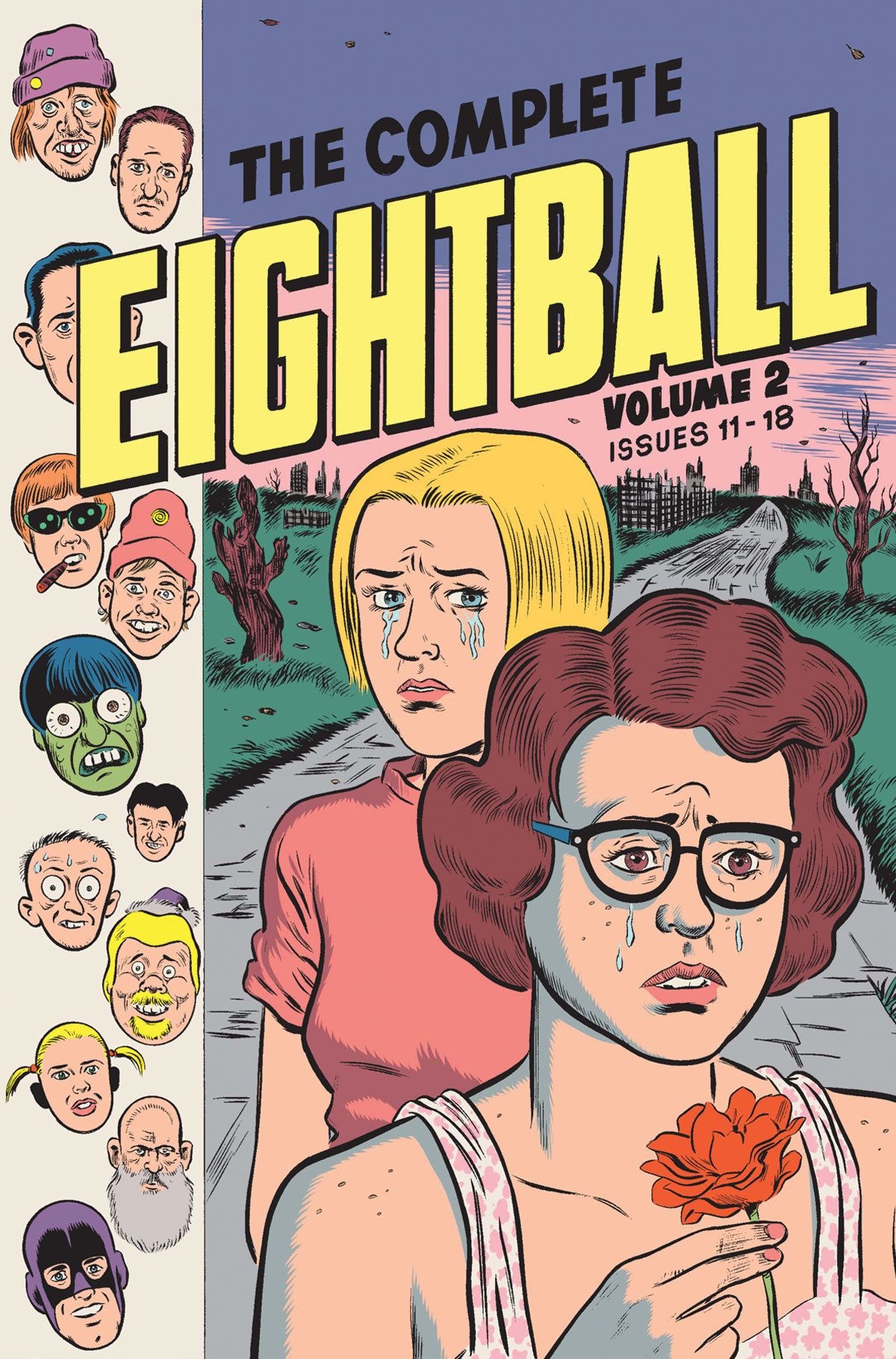
Let’s leave off this week with a glorious image. Eightball ran for 18 issues from 1989 to 1997 and was the medium for such classics as “Art School Confidential”, “Live a Velvet Glove Cast in Iron,” “Ghost World” Dan Pussey and more more more. Traversing the gulf from rough humor comics of the 80s to the intimate details of the 90s, it’s an essential for the smallest comics shelf possible. The book drops in June and Vice talks to The Man “We came out of an era that was just moribund in comics.” Clowes says over the phone from his home in California. “The original guys who’d revitalised Marvel in the 60s had faded, and they were replaced by guys imitating them, who were then replaced by guys imitating them, it was this fourth generation of boring, awful comics. At the same time all the head shops, all the drug paraphernalia shops were being closed down – and they were where underground comics by the likes of Robert Crumb would be sold, so that was disappearing as well. There was nothing, it felt dead. But there was a whole generation of us who’d grown up on Mad magazine and National Lampoon and the comedy of Monty Python and Richard Pryor, and we wanted to do good comics. All of a sudden these people started to appear all over the country, trying to do something different, it was a miracle that we got an audience. We were a very, very small offshoot of the comics industry – it didn’t feel like we were taking over anything…”

Blog: Perpetually Adolescent (Login to Add to MyJacketFlap)
JacketFlap tags: Graphic Novels, Comics, Chris Ware, Persepolis, Marjane Satrapi, The Reading Life, Art Spiegelman, Maus, Ghost World, Scott Pilgrim, Bryan Lee O'Malley, Daniel Clowes, Matt Fraction, Seconds, Building Stories, sex Criminals, Chip Zdarsky, Michael Kitto, Hawkeye: My Life as a Weapon, Jimmy Corrigan, Add a tag
 I consider myself a big nerd and comics seem to go hand in hand with the social status. I never really got into comics (or graphic novels) and when I did attempt I never knew where to start. There are millions of reboots and story arcs for the thousands of different superheroes out there but which ones are good and where do I start? It was Scott Pilgrim that started my journey into graphic novels and with Bryan Lee O’Malley’s Seconds recent release, I thought now would be a perfect time to talk about the graphic novels I love.
I consider myself a big nerd and comics seem to go hand in hand with the social status. I never really got into comics (or graphic novels) and when I did attempt I never knew where to start. There are millions of reboots and story arcs for the thousands of different superheroes out there but which ones are good and where do I start? It was Scott Pilgrim that started my journey into graphic novels and with Bryan Lee O’Malley’s Seconds recent release, I thought now would be a perfect time to talk about the graphic novels I love.
As an easy way to distinguish between comics and graphic novels, I call single issues (30-40 pages) a comic and a graphic novel is the anthology that contains a full story arc (normally 4-5 single issues). What I find really interesting about a graphic novel is that it is simply a new way to tell a story. It is not always about the superhero, graphic novels can explore high concepts in a whole new way.
Take the only graphic novel to win a Pulitzer Prize, Maus by Art Spiegelman. In this story we read about Vladek Spiegelman and his wife, it is biography of living and surviving Hitler’s Europe. The graphic novel not only addresses the holocaust and life in a war torn country it does it in a unique way. Exploring the reality and fears of surviving in a visual way, the Jews are depicted as mice and the Nazi’s hunting them as cats.
 There is also the autobiographic story of Marjane Satrapi in Persepolis, a coming of age story of a girl living in Tehran during the Islamic Revolution. The whole concept of cultural change works really well in this graphical depiction. There is even an animated adaptation which is worth checking out (even if it is exactly the same). If you prefer a more quasi-autobiographical story maybe try Ghost World by Daniel Clowes or even something by Chris Ware like Jimmy Corrigan or Building Stories.
There is also the autobiographic story of Marjane Satrapi in Persepolis, a coming of age story of a girl living in Tehran during the Islamic Revolution. The whole concept of cultural change works really well in this graphical depiction. There is even an animated adaptation which is worth checking out (even if it is exactly the same). If you prefer a more quasi-autobiographical story maybe try Ghost World by Daniel Clowes or even something by Chris Ware like Jimmy Corrigan or Building Stories.
 Finally, if you prefer your graphic novels to be about superheros or people coming to terms with their new found powers, I have some suggestions for you as well. Hawkeye: My Life as a Weapon by Matt Fraction is the first story arc in this new Hawkeye series and explores a life of a superhero outside fighting crime and saving the world. Also by Matt Fraction, with the help of Chip Zdarsky is the weird and wonderfully dirty Sex Criminals. This is a story of a woman that discovers that time freezes after an orgasm and the shenanigans she can get up to with so much quiet time. This graphic novel will not be for everyone; if you want something very different that is full of dirty visual puns then I would recommend it.
Finally, if you prefer your graphic novels to be about superheros or people coming to terms with their new found powers, I have some suggestions for you as well. Hawkeye: My Life as a Weapon by Matt Fraction is the first story arc in this new Hawkeye series and explores a life of a superhero outside fighting crime and saving the world. Also by Matt Fraction, with the help of Chip Zdarsky is the weird and wonderfully dirty Sex Criminals. This is a story of a woman that discovers that time freezes after an orgasm and the shenanigans she can get up to with so much quiet time. This graphic novel will not be for everyone; if you want something very different that is full of dirty visual puns then I would recommend it.
I would love to recommend more comics but some of my suggestions are not yet released as a complete story arc yet. If you are interested in more graphic novel suggests let me know in the comments below. I hope this will give you some suggestions if you have never tried a graphic novel before. I’m also happy to take more recommendations in the comments below. Happy reading.
Add a CommentBlog: PW -The Beat (Login to Add to MyJacketFlap)
JacketFlap tags: fine art, Top Shelf, espionage, Frank Miller, daredevil, Daniel Clowes, Top News, Matt Kindt, WonderCon 2013, Eightball, MIND MGMT, Superspy, Travis Langley, News, Interviews, Events, Comics, Indies, Dark Horse, Add a tag
You’d be forgiven if you think of Matt Kindt as a breakaway success, since the “slow and steady” approach that’s defined his career so far looks like a sprint to the finish line with the explosive success of MIND MGMT from Dark Horse. Educator and author Travis Langley (Batman and Psychology) sat down with Kindt in a marathon 90 minute interview panel with the enigmatic creator on March 30th as part of the Comic Arts Conference at WonderCon. This “Focus” series event revealed just how long a road it has been for Kindt to reach his current level of exposure and fandom with MIND MGMT, a comic series about the dark legacy of a government spy agency staffed by agents with psychic abilities.
 Kindt, who says he’s probably been best know for his graphic novel SUPERSPY prior to MIND MGMT, had an unusual experience with comics at the age of 7 or 8 years old that left a big impression on him and still continues to influence his work. Reading Frank Miller’s DAREDEVIL, he ploughed through an entire issue where Daredevil visits Bullseye in the hospital, now paralyzed (following his murder of Elektra) and repeatedly pulls the trigger on his gun at the murderer. The issue itself consists of Daredevil speaking to the comatose Bullseye with almost no action at all, and as a kid Kindt thought “What kind of crazy superhero stuff is this?”. The heavy, odd dialogue and the “threat” of the unloaded gun, Kindt said, “made me love comics”. After a period in the 90’s when superhero books weren’t “capturing” Kindt’s attention anymore, he had another epiphany after discovering Daniel Clowes’ series EIGHTBALL at a con. He immediately felt, upon reading the issues, “This is the kind of comics I want to do” and an indie sensibility was born. Enter the years of hard work and learning just how to produce comics with his own particular voice.
Kindt, who says he’s probably been best know for his graphic novel SUPERSPY prior to MIND MGMT, had an unusual experience with comics at the age of 7 or 8 years old that left a big impression on him and still continues to influence his work. Reading Frank Miller’s DAREDEVIL, he ploughed through an entire issue where Daredevil visits Bullseye in the hospital, now paralyzed (following his murder of Elektra) and repeatedly pulls the trigger on his gun at the murderer. The issue itself consists of Daredevil speaking to the comatose Bullseye with almost no action at all, and as a kid Kindt thought “What kind of crazy superhero stuff is this?”. The heavy, odd dialogue and the “threat” of the unloaded gun, Kindt said, “made me love comics”. After a period in the 90’s when superhero books weren’t “capturing” Kindt’s attention anymore, he had another epiphany after discovering Daniel Clowes’ series EIGHTBALL at a con. He immediately felt, upon reading the issues, “This is the kind of comics I want to do” and an indie sensibility was born. Enter the years of hard work and learning just how to produce comics with his own particular voice.
 Kindt’s education in fine art and painting, still evident in his comics work, influenced him tremendously in making comics, he told Langley. To “know production” and “have control of every part of the process” of making comics now serves him well, but as an art student at Webster University, he “kept comic books a secret”, since they were not considered an “art form” by his instructors. The most rewarding skill he acquired, Kindt explained, turned out to be print-making. Even though it’s not a “discipline directly related”, its application to comics proved invaluable. “It helped me think about color and composition”, he said, and through print making he acquired one of his key concepts when it comes to making comics, “movement in production”, a phrase his print making instructor used that “still haunts” him. For Kindt, “movement in production” means not being “precious” about a particular stage of production and reminds him not to “hold onto things” but keep his comics output moving. It results in the fairly profound productivity readers see today from Kindt.
Kindt’s education in fine art and painting, still evident in his comics work, influenced him tremendously in making comics, he told Langley. To “know production” and “have control of every part of the process” of making comics now serves him well, but as an art student at Webster University, he “kept comic books a secret”, since they were not considered an “art form” by his instructors. The most rewarding skill he acquired, Kindt explained, turned out to be print-making. Even though it’s not a “discipline directly related”, its application to comics proved invaluable. “It helped me think about color and composition”, he said, and through print making he acquired one of his key concepts when it comes to making comics, “movement in production”, a phrase his print making instructor used that “still haunts” him. For Kindt, “movement in production” means not being “precious” about a particular stage of production and reminds him not to “hold onto things” but keep his comics output moving. It results in the fairly profound productivity readers see today from Kindt.
Another benefit of studying fine arts, Kindt said, was to “learn about everything” and learn to make art before learning to make comics. Learning to make comics from observing comics is fine, he assured the audience, but it is “limiting the scope of how you think about comics”. Kindt, who’s known for his use of watercolor and tirelessly inventive design of marginalia in his work, is a pretty good living example of his point. By bringing in tools and tricks learned in other art forms, he expands awareness for readers and creators about what the comics format can do.
 Kindt told Langley that he started off self-producing mini comics after attending ‘zine shows and first learned there about the common saying that a comics artist has to produce a thousand pages before they really produce one good one. The idea stayed with him as he watched his page count climb over the years. Inspired by autobio comics, he started producing them, meanwhile working his “boring day job”. “Every job was boring to me if I was not doing comics”, he confessed, and added that for him, “Everything has to have a dual purpose”. He worked in cinemas and bookstores to get discounts and continue to explore new artistic influences as part of his “dual purpose” of producing comics.
Kindt told Langley that he started off self-producing mini comics after attending ‘zine shows and first learned there about the common saying that a comics artist has to produce a thousand pages before they really produce one good one. The idea stayed with him as he watched his page count climb over the years. Inspired by autobio comics, he started producing them, meanwhile working his “boring day job”. “Every job was boring to me if I was not doing comics”, he confessed, and added that for him, “Everything has to have a dual purpose”. He worked in cinemas and bookstores to get discounts and continue to explore new artistic influences as part of his “dual purpose” of producing comics.
 After graduating from college, Kindt worked at a “small design firm” and “hated it” despite the fact that it was art related. The “cubicle” environment depressed him and so he would speed through his required work and then “blatantly write comics after the work was done”. He rather ingeniously drafted and planned the comics while at work, so once home, “pages were ready to draw”. Kindt’s answers during this part of the interview were particularly funny as he broke into detailed narratives, but the most memorable vignette concerned using company color photocopiers to produce his comic covers after hours. “I don’t recommend this”, he warned regarding this strategy. Using special, thick paper for the covers, Kindt patiently kept copying despite the fact that the printer would jam every few copies. Finally, one cover “melted to the copier”, imprinting the drum of the copier with the cover image, including his name in clear script. After panicking, then realize there was simply nothing he could do about it, he knew he was “screwed” and left it. He returned to work without saying anything about it, watched the copier being repaired, and waited for the shoe to drop. It never did. His employers, for whatever reason, decided to turn a blind eye.
After graduating from college, Kindt worked at a “small design firm” and “hated it” despite the fact that it was art related. The “cubicle” environment depressed him and so he would speed through his required work and then “blatantly write comics after the work was done”. He rather ingeniously drafted and planned the comics while at work, so once home, “pages were ready to draw”. Kindt’s answers during this part of the interview were particularly funny as he broke into detailed narratives, but the most memorable vignette concerned using company color photocopiers to produce his comic covers after hours. “I don’t recommend this”, he warned regarding this strategy. Using special, thick paper for the covers, Kindt patiently kept copying despite the fact that the printer would jam every few copies. Finally, one cover “melted to the copier”, imprinting the drum of the copier with the cover image, including his name in clear script. After panicking, then realize there was simply nothing he could do about it, he knew he was “screwed” and left it. He returned to work without saying anything about it, watched the copier being repaired, and waited for the shoe to drop. It never did. His employers, for whatever reason, decided to turn a blind eye.
The job provided “motivation” for Kindt due to his profound desire to get away from an office job. He knew at the time, he said, “I’ll never be happy”. He was aware that he needed to “either fail or succeed at the thing I wanted to do most”. “Mocking” copies up at Kinkos at twenty dollars a piece, he printed 20 books and physically took the books to Dark Horse, Top Shelf, and Fantagraphics booths at a show in Chicago. By this time, Kindt had moved beyond autobio comics because he was getting a sense of “horrible feedback” from spending all day at a job he hated and then writing about it again in his comics. From making a list of things he wanted to draw, he concocted stories to allow him to do it. The list, he said (to laughter from the audience) included pirates, elements of old radio shows, and circus freaks. After handing over the hard-won comics to publishers, Kindt was more than amazed to receive a phone call at home. For Kindt, he still remembers the call as his “greatest moment”. Top Shelf wanted the book, “just as it is”. Ironically, the only change they wanted to make was to the melted cover.
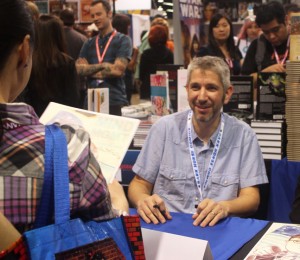 Kindt went on to learn a host of lessons in an uphill struggle to make a living in comics, from realizing that collaboration was just not his thing, to challenging himself (never again, he said) to create an entire graphic novel without a single narrative box, resulting in a 300 page tome, to the realization that with his book SUPERSPY, he had finally reached his 1000th page. Just on time, SUPERSPY took off in ways his previous critically acclaimed works had never managed to achieve.
Kindt went on to learn a host of lessons in an uphill struggle to make a living in comics, from realizing that collaboration was just not his thing, to challenging himself (never again, he said) to create an entire graphic novel without a single narrative box, resulting in a 300 page tome, to the realization that with his book SUPERSPY, he had finally reached his 1000th page. Just on time, SUPERSPY took off in ways his previous critically acclaimed works had never managed to achieve.
Langley then led Kindt into the spy-obsessing portion of the interview, one which provoked a great deal of enthusiasm from the audience. Kindt, surprisingly, said that his espionage-based current work MIND MGMT, is not “really about spies”. He confessed that spy literature and film formed an early influence on his life from a family-bonding trip to a drive-in theatre to see MOONRAKER onward. The travel-writing aspect of spy novels were what Kindt found particularly appealing, churning through all the works of Ian Fleming as a teen. When he reads spy books or watches films now, however, he has a particular strategy in mind. He’s deciding what he’s “not going to put in books” since they’ve already been done by a process of “elimination”.
Kindt’s books now, and increasingly, show his obsession with “gadgetry” to the point that even close personal friends in comics (he mentioned Cullen Bunn and Jeff Lemire as examples) tease him about it, but it’s all part of the “physicality” and “interactive” aspects of printed comic books that appeals to Kindt. MIND MGMT is Kindt’s first fully serialized work where he is functioning as both writer and artist, and he’s taken advantage of that fact to emphasize the capabilities unique to print books, loading the inner covers of the comic, for instance, with extras for fans of spy lore. MIND MGMT contains features like a “field guide” format to its borders, Kindt explained, as if the comic is being presented within a field guide for secret government agents. Kindt also revealed that he’s particularly passionate about the role of covers in printed comics as the “very first page of the story” that has to function and work as simply a cover but also “work in a narrative way”.
 Though the question and answer period was generous and wide-ranging, covering his artistic processes, research for his books, and upcoming plans for MIND MGMT, Kindt’s passion for printed comics became a particularly hot topic. Working on a monthly book that is available in digital formats but contains incentives for print collection helps “get people back into shops every week”, Kindt explained, and may lead to readers discovering new books they like along the way rather than simply waiting for trades. He’s not averse to digital formats, he assured the audience, and reads many comics in digital format, but as a designer he’s concerned that “digital should be designed to be digital” and is not a fan of simple relocation of formats without attention to detail.
Though the question and answer period was generous and wide-ranging, covering his artistic processes, research for his books, and upcoming plans for MIND MGMT, Kindt’s passion for printed comics became a particularly hot topic. Working on a monthly book that is available in digital formats but contains incentives for print collection helps “get people back into shops every week”, Kindt explained, and may lead to readers discovering new books they like along the way rather than simply waiting for trades. He’s not averse to digital formats, he assured the audience, and reads many comics in digital format, but as a designer he’s concerned that “digital should be designed to be digital” and is not a fan of simple relocation of formats without attention to detail.
I asked Kindt, as the final question of the panel, what psychic powers he would like to have if he could somehow acquire them. His list was as down-to-earth as the hour and a half chat he shared with WonderCon goers: remember peoples’ names and be less oblivious. “I’d make the worst spy”, he confessed, “I can’t remember anything”. All a ploy to throw fans off the scent? Hearing a portion of the full story behind Kindt’s seemingly meteoric rise makes something clear once again about working in comics: it entails work, work, work, and more work, but it also demands commitment and passion. It’s not an easy combination to emulate, but for Kindt it’s been the only way to be truly happy.
Photo Credits: All photos in this article were taken by semi-professional photographer and pop culture scholar Michele Brittany. She’s an avid photographer of pop culture events. You can learn more about her photography and pop culture scholarship here.
Hannah Means-Shannon writes and blogs about comics for TRIP CITY and Sequart.org and is currently working on books about Neil Gaiman and Alan Moore for Sequart. She is @hannahmenzies on Twitter and hannahmenziesblog on WordPress.
Blog: Mishaps and Adventures (Login to Add to MyJacketFlap)
JacketFlap tags: Dahmer, comics, Chip Kidd, Mars Attacks, New York Comic con, Garbage Pail kids, Daniel Clowes, Abrams ComicArts, Charles Kochman, Add a tag
Blog: DRAWN! (Login to Add to MyJacketFlap)
JacketFlap tags: comics, R. Crumb, Daniel Clowes, Add a tag
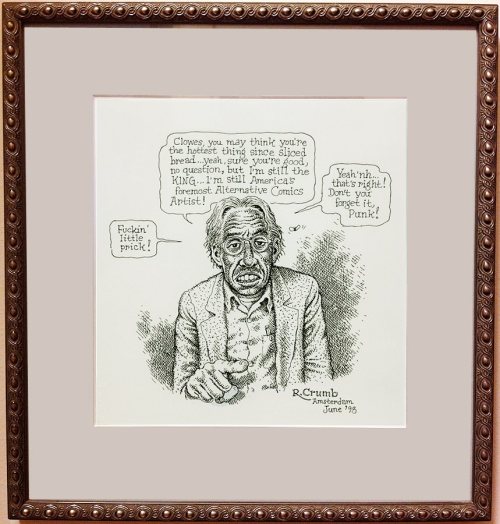
R. Crumb sticks it to Daniel Clowes, via danielclowes.com on Facebook
Blog: DRAWN! (Login to Add to MyJacketFlap)
JacketFlap tags: comics, Daniel Clowes, Add a tag
Daniel Clowes talks about his art for the New York Times.
Blog: DRAWN! (Login to Add to MyJacketFlap)
JacketFlap tags: comics, documentaries, Daniel Clowes, Add a tag
A 2002 documentary on Daniel Clowes from Dutch television.
Blog: DRAWN! (Login to Add to MyJacketFlap)
JacketFlap tags: comics, websites, Daniel Clowes, Add a tag

Daniel Clowes got a pretty new website!
(apparently reluctantly: don’t miss the About page.)
Blog: Children's Illustration (Login to Add to MyJacketFlap)
JacketFlap tags: comics, DANIEL CLOWES, Add a tag
(not "children's" illustration)
Daniel Clowes Part (BBC Documentary)
Uploaded by lesebb1. - Classic TV and last night's shows, online.
Blog: PW -The Beat (Login to Add to MyJacketFlap)
JacketFlap tags: History, Podcasts and other media, Daniel Clowes, Add a tag
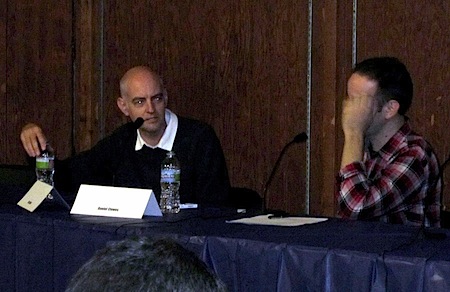
Should comics panels be written about or recorded for all to hear?
This panel report from APE of Dan Nadel interviewing Daniel Clowes has been linked everywhere, probably because it’s such a thorough write-up. There’s lots of dish on other cartoonists, and anecdotes from the history of alt.comix:
Clowes told a story how the first panel he was ever on was comprised him, Robert Crumb, Gilbert Hernandez, Peter Bagge and Burne Hogarth. Hogarth spent the entire panel yelling at the independent cartoonists on the panel, saying how they were horrible artists.
“He spent almost an entire hour saying how we were the worst artists who ever lived,” recalled Clowes. “It was an audience full of young, hipster kids who wanted to see Robert Crumb and Crumb was not saying a word because Hogarth was rambling on. People started yelling out, ‘Shut up, old man!’ and finally Crumb just slowly leaned back in his chair and did a pratfall. Hogarth didn’t miss a beat, though, he just kept on going. I literally did not say a word on that panel.”
It’s probably been widely quoted because instead of the usual “Where did you get your ideas for WILSON?” questions, Nadel is comfortable enough with Clowes to just rap about comics, as suggested by Peggy Burns.
There’s finally audio of the panel up at Comics Comics, so you can listen for yourself.
Which reminds me of a growing beef — why is the set-up for recording panels at conventions so crap? During the ICV2 Digital and Comics Conference I tried to record them on my Mac but the ambient room audio eluded my technical ability. Milton Griepp used his little dictaphone but the quality wasn’t the best. I have to admit, I think we both screwed the pooch there with something that the average 12-year-old would be able to handle.
I recorded a few NYCC panels with my iPhone — the quality is fine for spoken word purposes. It takes a few minutes to clean and upload the audio files. In short, this is child’s play. So why aren’t all comics panels routinely recorded? I was told that at PAX, the video game conference, they record all the panels and CHARGE for the audio.
Part of this may be the lowly origins of the comic book convention panel. Having been on untold panels in my lifetime, I can attest to the fact that they range from horrific hungover Sunday exercises in awkward phrasing and long pauses best left in the scrapheap, to stimulating once-in-a-lifetime meetings of the mind. But of late it turns out we comics folks have a lot to say and a lot of Internet to say it on. Perhaps the time has come to archive more of these slices of history.
Thankfully, someone with a decent mike was able to record the Nadel/Clowes panel. But we’ve lost a lot of other pieces of our comics heritage along the way. Unless they are all in Mike Catron’s garage somewhere….but that is a post for another time.
Blog: Children's Illustration (Login to Add to MyJacketFlap)
JacketFlap tags: DANIEL CLOWES, comics, tribute or whatever, Add a tag

Blog: DRAWN! (Login to Add to MyJacketFlap)
JacketFlap tags: Books, Illustration, Comics, Daniel Clowes, Add a tag
Daniel Clowes’s new graphic novel Wilson comes out next week. I’ve read it, and loved it.
The antihero Wilson is a not unfamiliar Clowes character. He’s a cynical loner type reflecting on a life of failed relationships, both familial and romantic.
But where it gets interesting for me is in the cartooning itself.
The story is made up of individual standalone one-page gags, each reminiscent of a large Sunday comic strip, but telling a larger story when stitched together. This sense of reading the Sunday funnies is compounded by Clowes’s decision to draw these pages in a wide range of cartoon styles, each different from the next. So the reading experience is both entirely familiar, and unlike anything else I’ve read.


The variety of form makes it a book that highlights how comics are used to tell stories, as much as it tells one itself. And perhaps, too, it reflects how moments in our lives take on different forms in our memories. Then again, as someone who often finds it difficult to sustain or commit to a style for too long, I probably would have found the process of switching it up to be quite freeing. But as Tom Spurgeon says in his review, it’s “the hook for comics book club meetings, Internet chats and convention dinners for months if not years to come.” It’s an effect that gives Wilson a unique way with which to engage the reader. Each page is an encapsulated micro story, one which you can stop to study further, or quickly move past to get to the next.
I’m looking forward to seeing Clowes at TCAF in a few weeks. He kicks off the Toronto event with a presentation of the book.
Posted by John Martz on Drawn! The Illustration and Cartooning Blog |
Permalink |
No comments
Tags: Books, Comics, Daniel Clowes










Can’t wait to see the white studio execs squirming when Chris Rock lets loose on Oscar night.